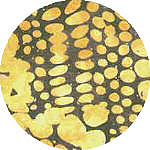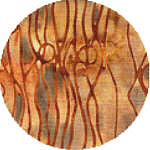 |
|||||||||
A few years back, I was fortunate enough to spend two long months in the paradisiacal islands of Bali and neighboring Lombok. My then girlfriend was fond of wearing sarongs and hoping to find traditional batiks. It quickly became clear that the tourist traps were no longer supplied by old world artisans who plied the time-honored trade of lengthy and hand-applied wax processes and secret recipe vegetable dies. The younger generation was keen on a quicker and easier buck. They had shifted operations to one-sided prints and modern textile paints to produce high-volume look-alikes. Successful sell-through to easily pleased tourists must have seemed more than enough justification to abandon the hallowed ways of their forebears. |
|||||||||
 |
Then we chanced upon an antiques dealer who would drive us to tiny villages off the beaten paths. His ancient Toyota Jeep was dilapidated and threadbare but exuded a rare and semi-military confidence. The fellow himself was charming and resourceful - a kind of retired general who surveyed his subjects in their colonial holdings with the fondness of hindsight. Over the years, his hunting grounds for authentic antiques had spiraled into the remote outer islands. Interior designers from abroad had decimated the native inventory like a plague. He predicted that authentic batiks could soon go the way of the dodo as well, replaced by inferior and cheaper fakes. To see the real deal, his ingenuity and personal connections were like a secret handshake or hacker-proof pass word. |
||||||||
Upon arrival in these villages, he'd dismount his carriage to briefly disappear in a few thatched roof huts. We'd hear rapid and excited dialogue like fluttering bird song. Soon thereafter, the native women would parade outside dressed in their customary sarongs that were faded by sun, age and work. Teased by the more ribald young ones to gyrate their hips and impress the foreigners, the shy mature ladies wearing the classic patterns and gorgeous colors would soon get into the spirit of impromptu barefoot fashion shows. They'd cheer each other, feign severe distress when my girl passed on their present wraps but immediately remind one another of fabrics still folded away in their prospective dressers and huts. Should my blonde companion finally nod her head in approval, they'd engage in clamorous negotiations with our translator to liberate this pretty American from some of her fabulous US currency. Native selling skills soon silenced their probable wonder over why a foreigner would be intrigued enough with their modest house dresses to buy them right off their hips. The answer to that question not only encompasses the raison d'être for nOrh the Thai company, it also explains why you might be interested in their SM 6.9 loudspeaker beyond its superb performance and shocking affordability. |
|||||||||
 |
|||||||||
 |
|||||||||
|
When handmade really means what it says Unlike Paul diComo's crafty ad campaign for Polk Audio that shows white-coated doctore Matthew Polk with chisel and wood shavings leaning on a loudspeaker that's manufactured in an hi-tech robotics plant in Mexico, nOrh loudspeakers are really made by hand. Whether from wood, ceramics, real marble or synthetic marble as the review pair, the company's culture revolves around the traditional artisan approach. Hand-in-hand with this manual labor go slight but natural material imperfections that spell clearly "no plastic" but point at the equivalent markers inside fine leather textiles or wood furniture. The sound of stone When I first interviewed for my sales & marketing position with the Soliloquy Loudspeaker Corporation many years ago -- a payroll position long since changed to freelance contract writer -- I spotted a solitary black granite pair of the firm's 5.0s monitor in the president's office. It was a one-up that Phil Jones had fashioned as a personal gift. |
|||||||||
|
Stoned
|
|||||||||
 |
|||||||||
 |
|||||||||
 |
|||||||||
 |
|||||||||